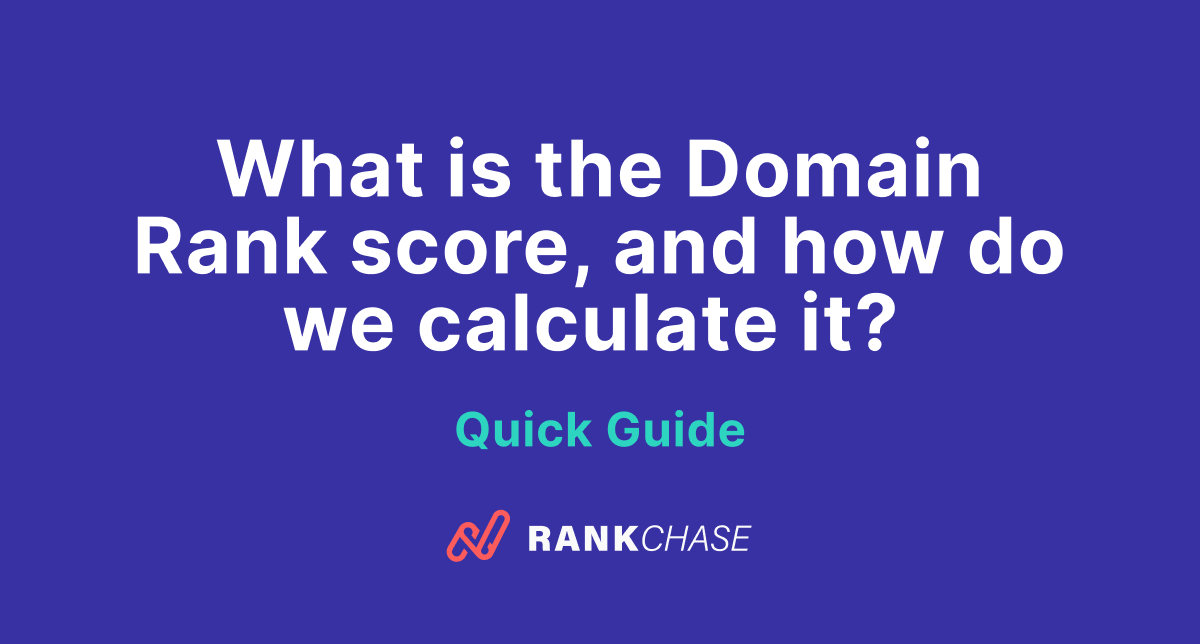BLOG ARTICLE
What is the Domain Rank score, and how do we calculate it?
Last updated: 4/13/2025
Last updated: 4/13/2025
Domain Rank (DR) is a simple yet powerful way to measure how authoritative a website is based on its backlinks.
Basically it is a score that tells you how much trust and influence a website has, which can help you decide whether to pursue a backlink from it, partner with it, or even analyze your own website’s performance.
For years, SEO professionals relied on Google’s PageRank, an algorithm that calculated the importance of web pages based on their links.
However, Google stopped making PageRank publicly available in 2016, leaving the SEO community to develop its own metrics. Now, tools like Ahrefs, Moz, SEMrush, and RankChase offer Domain Rank to give you a clear picture of a website's strength.

What Does Domain Rank Measure?
Domain Rank evaluates the strength of a website by analyzing its backlink profile—specifically the number and quality of other websites linking to it. It’s essentially a popularity score but with a strong emphasis on the quality of links rather than just the quantity.
It’s important to note that different platforms use different scales for their Domain Rank or authority metrics. For example:
- Ahrefs and SEMrush use a scale from 0 to 100, which compresses the range of scores into a smaller interval.
- Our platform, RankChase uses a scale from 0 to 1000, offering finer granularity. This means that small changes in a domain’s backlink profile are easier to observe and track over time.
Regardless of the scale, the purpose of these metrics remains the same: to help users assess the authority and trustworthiness of a domain relative to others.
Interpreting Our Domain Rank Scale:
- Low DR (25–35): Represents newer sites with few backlinks.
- Moderate DR (200–300): Reflects established sites with strong links from other trustworthy websites.
- High DR (500+): Indicates major websites with a large number of high-quality backlinks. These scores are rare and signify significant authority.
While the scales differ across platforms, the ranking systems serve the same purpose—evaluating backlink quality and overall domain authority. Our 0–1000 scale provides more precision, making it easier to spot incremental improvements or changes in a domain's profile.
Why Is Domain Rank Useful?
Domain Rank (DR) is most valuable as a comparative metric, giving you a sense of how a website's backlink profile stacks up against others in the same keyword universe. In other words, DR measures a site’s popularity and authority within the context of its industry or niche.
This means that having a higher DR is especially important when competing with other websites targeting the same search queries.
For example, if your competitors for a specific keyword have a DR of 50, aiming for a DR higher than 50 can improve your chances of outranking them in search results. However, if you’re competing in a small or highly specialized niche, even a site with a modest DR can hold significant relevance and authority within its field.
With that in mind, DR is not an absolute metric. It should always be used to compare websites operating in the same space, rather than being treated as a universal measure of value.
How Does Domain Rank Help?
- Building Backlinks: Backlinks from high-DR websites generally pass more authority and improve your rankings. However, keep in mind that links from niche-relevant websites can still be highly valuable even if they have a modest DR.
- Analyzing Competitors: DR scores help you assess how you measure up to others in your industry.
- Improving Your Own Site: Understanding DR helps you focus on earning better backlinks and optimizing your SEO strategy.
In summary, Domain Rank is most meaningful when viewed in the context of your industry, serving as a guide to help you outperform your direct competitors for the keywords that matter most.
How Is Domain Rank Calculated?
Our Domain Rank (DR) is based on principles inspired by Google’s original PageRank formula, adapted to reflect modern SEO practices. It evaluates not just the quantity of backlinks a website has, but also the quality of those links and how much authority each link passes.
Here’s how the calculation works in simple terms:
-
Number of Backlinks:
- The more links a site has, the higher its score—but only if those links come from credible sources. A high number of low-quality or spammy backlinks won’t significantly improve the DR and might even harm it.
-
Quality of Backlinks:
- Links from authoritative sites carry more weight than those from less reputable or spammy websites. For instance, a link from a well-established, high-DR site is far more valuable than multiple links from low-DR or irrelevant domains.
-
Number of Outbound Links on the Linking Page:
- The fewer outbound links a linking page has, the more authority it passes to each linked site a.k.a Link Juice. For example, a page with 10 outbound links distributes more authority per link than a page with 100 outbound links.
-
Logarithmic Scaling:
- The DR scale is logarithmic, meaning higher scores are progressively harder to achieve. Moving from a DR of 100 to 101 is much easier than moving from 500 to 501. This ensures that small changes in backlink quality or quantity have a noticeable impact at lower levels, while higher levels require significantly more effort to improve.
Breaking Down the Formula
The DR calculation uses a simplified version of Google’s PageRank formula:
PR(A) = (1 - d) + d (PR(T1)/C(T1) + PR(T2)/C(T2) + …)
What This Formula Means:
- PR(A): The PageRank (or DR) of the page being calculated.
- T1, T2…: The pages linking to the target page.
- C(T1): The total number of outbound links on each linking page.
- d: The damping factor, which represents the probability of a user stopping their link-clicking journey. For our calculations, this is set to 0.5.
Example: How Quality Is Considered in DR
Let’s say a target page has backlinks from three other pages:
- Page 1: DR of 400 with 32 outbound links.
- Page 2: DR of 300 with 40 outbound links.
- Page 3: DR of 200 with 5 outbound links.
Here’s how we calculate the DR of the target page:
PR = (1 - 0.5) + 0.5 (400/32 + 300/40 + 200/5)
Breaking it down:
- Page 1 contributes 400/32 = 12.5.
- Page 2 contributes 300/40 = 7.5.
- Page 3 contributes 200/5 = 40.
Total: PR = 0.5 + 0.5 (12.5 + 7.5 + 40) = 30.5
After rounding, the target page’s DR is 30.
Why Not All Backlinks Are Equal
Not every backlink contributes the same value to a site’s Domain Rank. Here’s how different types of links are treated:
- 301 Redirects: Pass full authority to the destination page.
- 302 Redirects: Pass partial authority, similar to standard links.
- Canonical Links: Pass full authority to the canonicalized page.
- Nofollow, UGC, and Sponsored Links: Do not pass authority but are still counted as backlinks.
This differentiation ensures that only meaningful links contribute to a website's DR.
Combining Domain Rank with Spam Score for a Precise Assessment
While Domain Rank measures the authority and trustworthiness of a website based on its backlink profile, it’s important to remember that no metric is perfect.
Google’s original PageRank was hidden from public view because many people attempted to manipulate it with bad practices, such as buying low-quality backlinks or creating link farms.
This is why combining DR with Spam Score becomes invaluable.
Spam Score identifies the likelihood of a website being associated with spammy behavior by analyzing factors like the structure of the domain, metadata, and the health of its backlink profile, such as the ratio of total backlinks to referring domains and the balance of external to internal links.
By using DR to measure authority and Spam Score to flag potential risks, you can gain a clearer, more comprehensive understanding of a website's overall quality.
How RankChase Helps
To make it easier for users to evaluate websites, RankChase provides both the Domain Rank and Spam Score together. This allows you to:
- Make Informed Decisions: Use DR to identify authoritative websites and Spam Score to assess their trustworthiness, helping you avoid risky sites.
- Choose Quality Partners: Find websites that are both relevant and credible for link-building or content exchanges.
- Target Strategically: Focus on building relationships with sites that strengthen your SEO efforts without the risk of spam-related penalties.
By combining these two metrics, RankChase empowers users to confidently decide which websites to contact for link or content exchanges.

Conclusion
Domain Rank is an essential metric for understanding a website’s authority and backlink quality.
Our Domain Rank closely follows Google’s original PageRank principles, ensuring reliable and actionable results. While metrics from Ahrefs, Moz, and SEMrush are helpful, our DR offers a unique perspective by combining modern SEO practices with a formula rooted in search engine history.
By combining Domain Rank with complementary metrics like Spam Score, you can take your SEO strategy to the next level and make smarter, data-driven decisions.